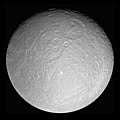Mynd:PIA07763 Rhea full globe5.jpg
Útlit

Stærð þessarar forskoðunar: 600 × 600 mynddílar Aðrar upplausnir: 240 × 240 mynddílar | 480 × 480 mynddílar | 768 × 768 mynddílar | 1.024 × 1.024 mynddílar | 2.048 × 2.048 mynddílar | 4.920 × 4.920 mynddílar.
Upphafleg skrá (4.920 × 4.920 mynddílar, skráarstærð: 2,67 MB, MIME-gerð: image/jpeg)
Breytingaskrá skjals
Smelltu á dagsetningu eða tímasetningu til að sjá hvernig hún leit þá út.
| Dagsetning/Tími | Smámynd | Víddir | Notandi | Athugasemd | |
|---|---|---|---|---|---|
| núverandi | 27. ágúst 2018 kl. 07:15 |  | 4.920 × 4.920 (2,67 MB) | PlanetUser | Reverted to version as of 08:13, 13 March 2015 (UTC) |
| 15. ágúst 2018 kl. 10:09 |  | 4.920 × 4.920 (2,66 MB) | The NMI User | Reverted to version as of 23:49, 14 August 2018 (UTC) | |
| 14. ágúst 2018 kl. 23:59 |  | 4.920 × 4.920 (2,64 MB) | The NMI User | rv, fixed | |
| 14. ágúst 2018 kl. 23:49 |  | 4.920 × 4.920 (2,66 MB) | The NMI User | Try making black | |
| 14. ágúst 2018 kl. 23:44 |  | 4.920 × 4.920 (2,65 MB) | The NMI User | Fixed | |
| 13. ágúst 2018 kl. 08:09 |  | 4.920 × 4.920 (3,67 MB) | The NMI User | Removing black borders | |
| 13. ágúst 2018 kl. 08:01 |  | 4.920 × 4.920 (2,67 MB) | The NMI User | Reverted to version as of 08:13, 13 March 2015 (UTC) | |
| 13. ágúst 2018 kl. 07:56 |  | 4.920 × 4.920 (5,67 MB) | The NMI User | Black background | |
| 13. mars 2015 kl. 08:13 |  | 4.920 × 4.920 (2,67 MB) | MoreTomorrow | making square (to match other planet/moon images) | |
| 30. október 2008 kl. 06:43 |  | 4.920 × 4.820 (2,68 MB) | WolfmanSF | This is the same full-resolution NASA image, with black panels added to the margins and some Photoshop processing to enhance contrast. |
Skráartenglar
Eftirfarandi síða notar þessa skrá:
Altæk notkun skráar
Eftirfarandi wikar nota einnig þessa skrá:
- Notkun á af.wikipedia.org
- Notkun á an.wikipedia.org
- Notkun á ar.wikipedia.org
- ريا
- ريا (قمر)
- جيوفاني دومينيكو كاسيني
- قالب:المجموعة الشمسية
- قائمة أجرام المجموعة الشمسية مرتبة حسب الحجم
- قائمة الأجرام المستديرة بالجاذبية في المجموعة الشمسية
- قائمة الأقمار الطبيعية
- خط زمني لاكتشاف كواكب المجموعة الشمسية وأقمارها
- اكتشاف واستكشاف النظام الشمسي
- قائمة أنواع الكواكب
- مهمة نظام تيتان زحل
- قائمة أكبر الفوهات في المجموعة الشمسية
- 1981 ميداس
- حلقات ريا
- قالب:ريا (قمر)
- Notkun á ary.wikipedia.org
- Notkun á arz.wikipedia.org
- Notkun á ast.wikipedia.org
- Notkun á as.wikipedia.org
- Notkun á azb.wikipedia.org
- Notkun á be.wikipedia.org
- Notkun á bh.wikipedia.org
- Notkun á ca.wikipedia.org
- Notkun á ckb.wikipedia.org
- Notkun á cy.wikipedia.org
- Notkun á de.wikipedia.org
- Notkun á el.wikipedia.org
- Notkun á en.wikipedia.org
Skoða frekari altæka notkun þessarar skráar.



